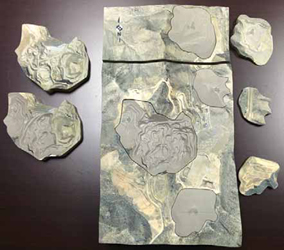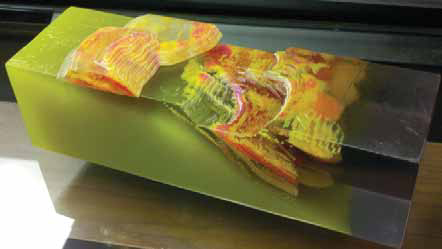 Powder bed and inkjet head printing is more costly than plastic
Powder bed and inkjet head printing is more costly than plastic
extrusion deposition printing. To create the print, powder plaster
or resin is deposited with a binder by an inkjet-like apparatus that
builds the model layer by layer. (Photos: Cypress 3D Printing)
Recent advances make 3-D printing an
economical means of creating multipurpose
models that effectively present technical
information to laypersons, such as
those found in public consultation meetings,
according to a consulting company
that specializes in the technology.
Compared to previous generations,
current 3-D printing technology, sometimes
referred to as additive manufacturing,
is now less expensive, more
user-friendly and faster, said Matt Blattman,
owner of Cypress 3D Printing (www.
cypress3dprinting.com). In mining, it is
an emerging technology enabling the creation
of models specialized for cost, audience
and purpose. Cypress 3D Printing
recommends its use when creating visual
representations of information, such as
mine plans and geologic interpretations,
to be delivered to external (non-technical)
customers. With 3-D printing, what
was traditionally expressed by maps or
posters, which can be challenging for laypersons
to interpret, can instead be expressed
by models. There are a number
of printer types, but the company summarized
the three most common types in
a recent presentation.
The least expensive 3-D printer type
is commonly carried by various retailers,
such as Sam’s Club and others. Extrusion-
based 3-D printing (fused deposition
modeling) takes raw plastic material, runs
it through a hot end, similar to a hot glue
gun, and lays it down in beads to build up
a 3-D model. If the model is of a building
structure or a pit design, the print will
emerge layer by layer, building upward.
Low cost makes this print process attractive,
said Blattman, a mining engineer.
The capital cost in purchasing an “extrusion-
based machine is in the range of hundreds
to a few thousand dollars,” he said.
Further, the materials, usually low end
plastics, are cheap. A 2-pound (lb) roll of
material currently costs roughly $50.
“The sacrifice is you get a much less
precise 3-D printer,” Blattman said. It
provides a more abstract model because
product shape, texture, definition and color
will be limited, he said. “You are going
to get models that are a single color and
you’ve got to take that into consideration.”
 Extrusion deposition 3-D printing is low-cost but also comparatively less precise. To generate prints, plastic
Extrusion deposition 3-D printing is low-cost but also comparatively less precise. To generate prints, plastic
beads
are deposited by a nozzle head in layers.
More expensive and dynamic, powder
bed and inkjet head 3-D printing creates
models from digital and orthophotographic data, Blattman said. To portray a
plant or mining sites, inkjet head printing
uses high-resolution raster images, line
data or text data, which is conveyed by
the print. Further, it incorporates full color
into the design.
“The printer repeatedly puts down
thin layers (0.1 mm) of fine-grained powder
of some form, usually gypsum powder
or plastic powder. It infuses the powder
with colored binder to build the model,”
he said. The model will be more precise
and complex than it would be had it been
generated by an extrusion-based printer.
Inkjet head printing, however, can be
costly. “You have jumped up from hundreds
of dollars to thousands of dollars for
both the material cost and the machinery,”
Blattman said. Also, the resulting
print can be fragile. “Just because you
can print a part doesn’t mean that it will
be able to be transported to any locations.
It is very much like a ceramic and can be
less durable in that regard.”
At the high end of the 3-D printing
spectrum, Continuous Liquid Interface
Production (CLIP) applies a laser or ultraviolet
light to a liquid or resin to shape
and bind printing materials and build up
models. It generates more exact models
made from finer materials, Blattman said.
“What’s great about this is you are going
to get a much better print. You can get
high precision,” he said. “You can even
add an element of transparency to the
model and put multiple materials together.”
The drawback is CLIP is “by far” one
of the most expensive methods of 3-D
printing. Further, “if your intent is presenting
information to a stakeholder that
needs photographic information or textual
information, you are not going to be able
to put that in as easily, as the range of
colors are more limited than inkjet-based
printers,” Blattman said.
 Three-dimensional prints vary in cost, color, technical accuracy, durability and component materials.
Three-dimensional prints vary in cost, color, technical accuracy, durability and component materials.
This
stereolithographic print conveys geological strata, orebody seams and an open-pit mine plan.
Case Studies: Modeling Mining Operations
A crushed stone company headquartered
in Virginia approached Cypress 3D Printing,
seeking a way to present information
to regulatory agencies. They also sought
a medium with community education
capabilities, Blattman said. “The company
plans to fill these quarries with lakes
when they are done,” he said.
“They needed a removable piece. One
model shows the before information of the
pit design,” he added. “The second is the
same model with the lake pieces.”
The resulting model exceeded their requirements.
It conveyed the needed information
to a non-technical audience. The
stakeholders were a regulatory committee
that may not have been experienced interpreting
maps. The drawback was expense.
3-D prints pertaining to short-term planning
may be cost prohibitive, Blattman
said. “If you use it for short-term planning,
and you have to reprint and reprint every
year, it can be costly,” he said. “If you
are doing a life-of-mine or long-term mine
plan, it makes a lot more sense.”
Similarly, a mining company headquartered
in Chicago sought a model to
present to investors. They needed something
to show the impact of the expansion
of their mine, and to “give some context,”
Blattman said. “They wanted a 3-D mine
plan with removable pieces. In this case,
we got a little more involved in the presentation,
actually going into their digital
data and doing some preparation for
print. This one was a little more involved
where you have different stages and you
have alternatives to the pits they are trying
to portray to their investors, showing
that the sequence of events over time. It’s
a bit bigger of a model as well.”
 Powder bed printing can incorporate orthophotographic data and full color.
Powder bed printing can incorporate orthophotographic data and full color.
A model with breakouts can convey phases of an
operation or alternative
plans, which can then be presented to a non-technical audience such as
a regulatory committee.
The model enabled expression of technical
information to a non-technical audience;
however, the company used it internally as
well. “What they found, though, is it also
worked well for operations,” Blattman said.
“They would bring the model into the meetings
for operators and use it as a point of
reference. They could then bypass maps.”
A third client, an earthmoving operation
with substantial amounts of cut and
fill, sought a model that would convey volume
changes, where they were going to be
cutting next, and the sequencing for each
new operation location, Blattman said. “Alternatively
to the other ones, there was no
photographic information,” he said. “It was
all textual information that they could take
into their day-to-day operations and explain
what their long-term plan is and what
their short-term plan is to operators, and
show what kind of information they can get
across.” Notably, they found that they used
the model daily, which is not uncommon.
A model planned for one purpose often is
discovered to be useful for other ends.
There are a number of 3-D printing
technologies beyond those described here,
to include hybrids. Determining which is
most suitable for your needs depends on
your budget and your purpose, Blattman
said. “That is usually the decision matrix
for most things in this industry,” he said.
 Stereolithography or resin printing creates encapsulated models via photopolymerization, the process of
Stereolithography or resin printing creates encapsulated models via photopolymerization, the process of
light fusing
molecules, creating polymers, layers of which comprise a 3-D solid.
The presentation “Emerging Technologies
in 3-D Printing” was delivered by
Blattman Brothers Consulting, forerunner
to Cypress 3D Printing, at the 2016 Society
of Mining Engineers meeting, held
in Phoenix in February. Blattman can be
reached at contact_us@blattbros.com.
As featured in Womp 2016 Vol 12 - www.womp-int.com




